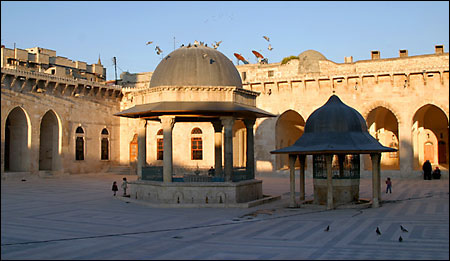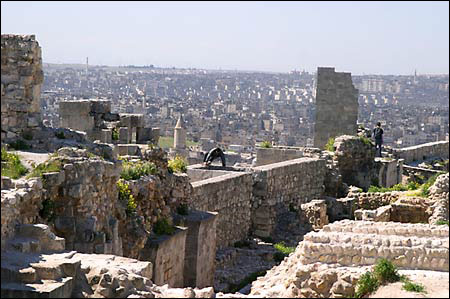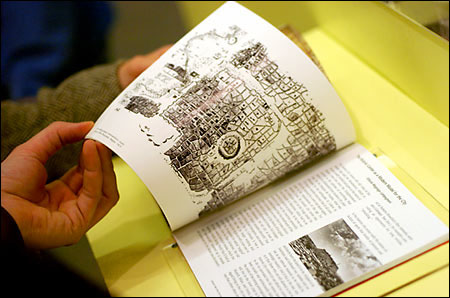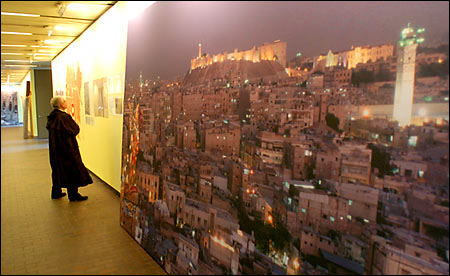New persectives on ancient city
GSD prize for urban design is awarded to Syrian city of Aleppo

It may be presumptuous for a university that is a mere 369 years old to tell a 5,000-year-old city, “Job well done.” Nevertheless, that is what Harvard has said to the city of Aleppo, Syria, by awarding it the Veronica Rudge Green Prize in Urban Design.
The Green Prize is awarded by the Harvard Design School (GSD) every two years to recognize excellence in urban design with an emphasis on projects that contribute to the public realm and improve the quality of a city’s urban life. This year the jury gave the prestigious prize to Aleppo for its rehabilitation and modernization of the ancient city center while maintaining the integrity and historical authenticity of the urban fabric.

The choice of Aleppo is unusual in that the emphasis is on bringing modern amenities to pre-modern neighborhoods in ways that are often invisible on the surface but vastly improve the quality of life.
“Aleppo shows us how urban rehabilitation in a historic setting can transmit a vital new meaning when the main focus is restoring urban fabric rather than rebuilding monuments,” wrote Joan Busquets, the Martin Bucksbaum Professor in Practice of Urban Planning and Design, who served as jury chair.

On Wednesday (April 13), the Design School held a symposium, “Aleppo: New Perspectives on the Old City,” followed by the presentation of the prize to Maan Chibli, the city’s mayor and a professor of urban planning and development at the University of Aleppo. An exhibition based on the project will be on display in the Gund Hall exhibition area through May 25.
‘City of Stone: Aleppo’s Rehabilitation’ is on display through May 25 in the Gund Hall Gallery at the GSD. Gallery hours are Monday-Thursday, 8:30 a.m.-10 p.m.; Friday, 8:30 a.m.-6 p.m.; Saturday, 10 a.m.-6 p.m.; and Sunday, 10 a.m.-8 p.m.
More information
According to Hashim Sarkis, the Aga Khan Professor of Landscape Architecture and Urbanism in Muslim Societies, Aleppo with its extensive souks or bazaars, its dense labyrinth of streets, its grand mosque, and its ancient citadel looming over the surrounding cityscape, has always represented the epitome of the Arab metropolis. Once the third largest city in the Ottoman Empire (after Istanbul and Cairo) and still renowned for its crafts, its cuisine, its music, and its multiculturalism, Aleppo inspires its inhabitants with an exceptional degree of civic pride.
“I believe the city center has been saved because of the high esteem in which Aleppines hold their city,” Sarkis said.

That pride is reflected in the uniquely grassroots manner in which the rehabilitation was conducted. While the renovation of the sewer system and other large-scale projects were undertaken by the municipal authorities with technical support by the German agency Gesellschaft für Zusammenarbeit (GTZ), much of the renovation of private dwellings was done by the inhabitants themselves with advice and subsidies from the city.
“These are mostly working class people, not yuppies,” said Busquets. “This shows that with limited means you can improve housing conditions so that normal people can live in these places.”
While political unrest has limited tourism in Syria, Busquets believes that with the renovation project nearing completion, Aleppo has the potential to become a major tourist destination. He hopes Aleppo’s achievement will serve as a model for cities in other developing nations.
With its giant photomurals and colorful maps, the exhibition does justice to Aleppo’s legendary beauty. The maps, which display various features of the city (monuments, infrastructure, souks, etc.), were digitally compiled from many different sources by 2004 GSD graduate Tomomi Itakura, then cut from bright red vinyl on a special automated machine. Applied to the lemon-yellow walls, the shapes have an eye-grabbing intensity.

“It’s difficult to do an exhibition on urban design,” said associate professor of architecture Monica Ponce de Leon, the curator of the exhibition and a member of the jury. “We decided to blow up the photographs and the figure-ground maps. I think the change in scale makes the material more accessible.”




